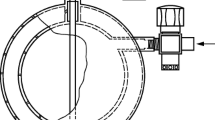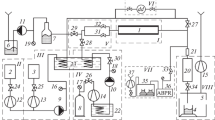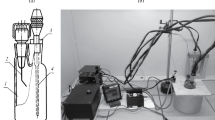Questions related to metrological assurance of the thermomechanical indicators of pre-explosive concentrations of hydrocarbons in the air using as an example the STM-30-50 plant are considered. Causes for the appearance of an additional error in these measuring instruments and methods of eliminating (decreasing) this error are analyzed.
Similar content being viewed by others
Avoid common mistakes on your manuscript.
Monitoring the air of the working zone of processing plants is conducted in order to prevent dangerous explosive situations. Thermomechanical indicators, for example, the STM-30-50 and other devices in this series produced by the Smolensk Anatpribor production association are widely used for this purpose. These measuring instruments are simple to use and possess a comparatively high degree of reliability. Nevertheless, they suffer from a number of drawbacks, in particular, those relating to metrological assurance.
In accordance with the operating documentation, calibration and adjustment of the indicators at the second alarm signaling threshold (11% of the lower concentration limit of flame propagation, LCL) are performed with respect to a methane control gas mixture (CGM) (calibration component). An additional error arises in measurements by such instrument of air mixtures with other components, and alarm signaling is triggered, for example, for benzene vapor once 20% of the LCL is reached. Such an assertion is not in accord with the requirements of the regulatory documents [1, sec. 3.2, 3.10; 2, sec. 2.7, 3.2, 2.7, 3.9], where it is determined that the limits of the permissible absolute error of the particular measuring instrument employed must be ±5% and alarm signaling must be triggered once 50% of the LCL is reached. A halt to the production process due to premature (less than 50% of the LCL) triggering of alarm signaling that the permissible level of concentration of hot gases and vapors in the air has been exceeded leads to unavoidable losses.
The operating manual of the STM-30-50 [3] presents the nominal static characteristics of the transformation of the indicator due to an output current signal together with specification of the proportionality factor (scaling ratios) for methane, hexane, and methyl acrylate. With the use of the conversion factors, the concentration of any component may be found (with defined error) by means of an indicator that has been calibrated with respect to a methane CGM and its value at which alarm signaling is triggered is determined. Precisely how to measure the concentration of other components, determine the levels of response of signaling to the established thresholds, and what is the error of the indicator are not specified in [3].
The operating principle of thermomechanical indicators is based on transformation of a thermal effect produced by oxidation of combustible gases and vapors on a catalytically active element of the sensor into an output signal. The sensitivity of the indicator is proportional to the diffusion coefficient of the measured component and inversely proportional to its LCL, expressed as a percentage of the volume fraction of the component (VFC). The higher the diffusion coefficient of the measured component, the greater is the proportion of its mass that will be transferred from the analyzed medium to the surface of the sensor’s sensing element per unit time and the greater will be thermal effect and the strength of the output signal. At the same time, the higher the volume fraction of the component, the lower is the strength of the output signal per unit volume fraction of the component that determines the LCL with constant range of output current, for example 4–20 mA.
The sensitivity of the indicator is defined as
where b is a coefficient governed by the structural parameters of the indicator device; D, diffusion coefficient of calibrated or measured component; and α, a coefficient equal to the fraction of the molecular mass of an organic compound governed by the atomic masses of the oxidized (combustible) components. For example, for oxygen-containing organic compounds:
m mCnHpO is the molecular mass of the measured component; the coefficients m, n, and p denote the quantity of carbon, hydrogen, and oxygen atoms, respectively; and A 0 is the total atomic mass of oxygen.
For alkanes, olefins, amines, and aromatic hydrocarbon, α = 1. Expression (1) is easy to use for calculating the scaling factors of an indicator, i.e., determining its relative sensitivity in the measurement of different components. The subscript “C” denotes quantities that belong to the calibration component and the subscript “M,” quantities that belong to the measured component. Then by (1) an expression for calculating the scaling factor has the form
To verify that (2) is correct, the mean scaling ratios \( {{\bar{K}}_{\mathrm{s}.\mathrm{e}}} \) are determined experimentally for air mixtures of the most common quantities relative to methane and hexane. The results are presented in Table 1; the values of the diffusion coefficients of the components in (2) are taken from [4] and the values of the LCL from [5].
Inspection is performed on STM-30-50 instruments that have been calibrated with respect to state standard specimens of a CGM of methane or hexane from a gas cylinder. Moreover, the scaling ratios are determined with the use of the 9010/9020 system (7600-type transducers, 14 units) produced in Germany.
A significant scatter of the data of up to ±30% and greater was established in an analysis of the results of measurements by different indicators. This may be explained by the fact that in a conversion from measurement of a CGM of methane to other gas mixtures there exists a scatter of the characteristics of the measuring instrument associated with the quality of manufacture and operating conditions of the primary transducers of the indicators, e.g., the quantity of applied catalyst, its purity and activity, degree of contamination of catalyst, etc. The scatter of the characteristics of the sensing elements is caused by the additional relative error of thermomechanical indicators in measurement of the gas mixture of the components [3, Appendix 2], which is equal to ±30%. The additional absolute error is variable and depends on the value of the measured quantity. For a range of measurements of the indicator of 0–50% of the LCL, the additional error varies from 0 to ±15% of the LCL, while the normalized error amounts to 5% of the lower concentration limit.
The results of an experimental determination of \( {{\bar{K}}_{\mathrm{s}.\mathrm{e}}} \) depend to a significant extent on the number of measuring instruments in the sample and the state of the sensing elements in the instruments. The experimentally obtained value of this coefficient for hydrogen is 5.6–6.6 times that of the calculated value (cf. Table 1). So great a deviation may be explained by the fact that a platinum catalyst is selective to hydrogen (its catalytic activity is highest precisely for hydrogen) as well as by the high calorific power of the latter.
The situation with experimental determination of the scaling ratio for multi-component mixtures, in particular, benzene vapors, is even more complicated. Results of a chromatographic analysis of samples of benzene show that it contains up to 200 components in the liquid state and two or three gaseous components (propane, butane, and sometimes ethane) absorbed by the liquid phase. From the results of a chromatographic analysis of a sample of vapor phase found in equilibrium with liquid in a closed vessel at a temperature of 22°C, it follows that the total volume fraction of the component of gaseous hydrocarbons amounts to 4.2% for C3 and 7.06% for all C4H x . So high a content of gaseous (C3, C4) hydrocarbons in the vapor phase is due to “light” desorption of absorbed gases from the liquid. Basically, desorption and volatilization of a gaseous component and the light liquid components of benzene determines its instability with respect to composition over time. Due to the instability of benzene and the labor content of the technique, experimental determination of K s does not make sense. It is simpler and more reliable to select an optimal CGM for calibration of indicators used in monitoring benzene vapors in air.
Table 2 presents the physical properties of certain basic components of benzene (including the diffusion coefficient D and pressure coefficient p s of saturated vapor [3]) and for purposes of comparison, the physical properties of basic components of methane as well as computed data that confirm that hexane is the optimal calibrated CGM for the STM-30-50 indicator in monitoring of benzene vapors in air. Moreover, Table 2 shows at what value of the LCL alarm signaling is triggered when measuring components that are present in the composition of benzene with adjustment of the second threshold to 11% of the LCL (factory plant) with respect to methane. The values do not exceed 20% of the LCL, thus representing premature triggering. The values of this quantity in the course of switching on alarm signaling when adjusting the measuring instrument with respect to a methane CGM to 40% of the LCL (second threshold) were also specified. The signal values fall in the range 28.6–42.1% of the LCL; the maximal deviations from the given value amount to 2.1 and 11.4% of the LCL. Expressed in terms of relative units, the scatter for hexane is in the range from –28.5 to +5.25%, and for methane, in the range from 17.3 to 72.7%.
The thermomechanical indicators do not exhibit the property of selectivity to a given component and are related to instruments for measuring a set of components. The output current of an indicator is determined by transformation of the thermal effect due to combustion of the total mass of components transported to the transducer’s sensing element. The device’s alarm signal is triggered at the moment the total volume fraction of the components attains a level equivalent to the specified value, expressed in terms of a percentage of the LCL of the calibrated component (in the present case, 40% of the LCL of hexane or some other given value). And this is independent of whether the signal concentration is caused by a particular component (for example, methane, ethane, propane, etc.) or by their totality for benzene.
A situation in which an alarm signal is triggered at a value of the LCL greater than 50% for any air mixture cannot arise in calibration of indicators or in the course of establishing the value of the second signaling threshold with respect to the hexane CGM. The device exhibits the greatest sensitivity in measurement of air mixtures of methane and hydrogen. The greater the sensitivity, the lower the value of the LCL at which an alarm signal is triggered; for methane it occurs at 24.4% of the LCL (cf. Table 2).
Conclusion. In the process of measuring gas mixtures by means of an indicator graduated with respect to the CGM of an unmeasured component, there arises an additional absolute error in the measuring instrument determined by the scatter of the sensitivity of the sensing element. This additional error may assume values from 0 to ±15% of the LCL (with a range of measurements of the measuring instrument 0–50% of the LCL).
To increase the reliability of the measurement results and decrease the additional error of indicators caused by replacement of a calibrated component by a measured component, calibration of indicators must be performed with respect to a CGM with a measured component in accordance with appropriate techniques.
When the air of the working zone of production plants is monitored in production of benzene by means of thermomechanical indicators graduated with respect to methane and with 2nd threshold of 11% of the LCL, an alarm signal is triggered relative to computed data (cf. Table 2) once 20% of the LCL for benzene vapors has been reached. The deviation from the normalized limit here amounts to 30% of the LCL, which is not in accord with the requirements of the regulatory documentation [1, 2, 5].
It was suggested that a hexane CGM should be used as a calibrated CGM for thermomechanical indicators when monitoring benzene vapors in the air of the working zone. The additional error of the indicators caused by replacement of the calibrated component by a measured component is thereby practically eliminated. The device’s alarm signal is triggered at the moment the total volume fraction of the component reaches a level equivalent to a specified value of the LCL of hexane.
Formula (2) was proposed for use in calculating conversion ratios, making it possible to determine the concentration of any component (from the list presented in the article) by an indicator that has been calibrated with respect to a CGM of a calibrated component. The relative deviation of the mean values of the scaling ratios found experimentally from those obtained from a calculation using (2) for the components presented in the article (except for hydrogen) does not fall outside the range ±12% (cf. Table 1). This mean value also depends on the number of devices in the sample and the quality of the sensing elements in these devices.
The scatter of the characteristics of the sensing elements for domestically produced primary transducers practically coincides with the scatter for the sensing elements of primary transducers produced in Germany (cf. Table 1).
The results of experimental studies confirm that the selected metrological assurance of the indicators is not correct. The use of a so-called calibrated methane CGM is responsible for the exceedance of the actual absolute error of an indicator relative to a normalized error and leads to premature triggering of alarm signaling (up to 20% of the LCL).
References
RD BT 39-0147171-003–88, Requirements for Installation of Sensors of Stationary Gas Indicators in Production Rooms and at Outdoor Sites of Enterprises in the Petroleum and Gas Industry.
Resolution of State Mining Technical Inspection Agency of the Russian Federation No. 54 (June 5, 2003). Safety Rules for Gas Processing Plants and Factories, www.zaki.ru, accessed June 8, 2012.
STM-30-50 Indicator, www.technoline.ru>catalog/product/1472, accessed June 8, 2012.
N. B. Vargaftik, Manual on Thermophysical Properties of Gases and Liquids [in Russian], Nauka, Moscow (1972).
TU-GAZ–86, Requirements on Installation of Indicators and Gas Analyzers.
Author information
Authors and Affiliations
Corresponding author
Additional information
Translated from Izmeritel’naya Tekhnika, No. 10, pp. 70–73, October, 2012.
Rights and permissions
About this article
Cite this article
Beloshitskii, A.P., Gavrilov, L.A. Measurement of the pre-explosive concentrations of hydrocarbons in the air of the working zone of the processing plants of oil-refining enterprises. Meas Tech 55, 1224–1228 (2013). https://doi.org/10.1007/s11018-012-0112-y
Received:
Published:
Issue Date:
DOI: https://doi.org/10.1007/s11018-012-0112-y




